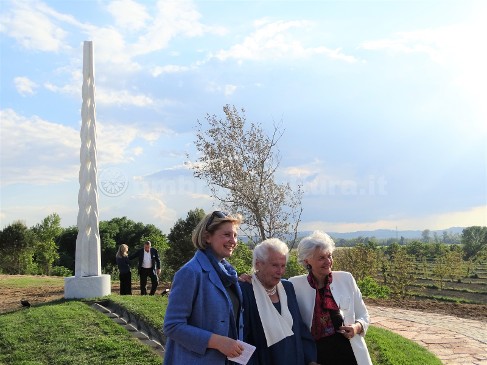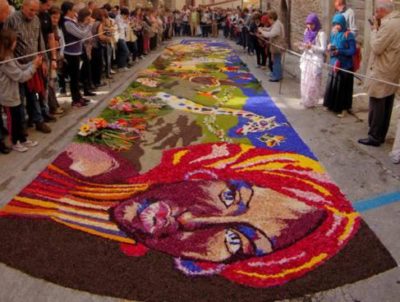Bassano in Teverina is the village you don’t expect. In Viterbo’s Tuscia, famous for its ancient roots and for the cultivation of the delicious hazelnuts, a short distance from Rome and the main road and railway lines, Bassano is a delightful happy island for those tired of city stress and looking for a haven of peace.
Recommended destination both for a holiday and for those looking for a more human-friendly lifestyle, Bassano in Teverina offers a very well preserved ancient village of medieval origin, impeccably restored, which lies on a tuff cliff 300 meters above the sea level. Peace, tranquility, excellent food, places of cultural interest and naturalistic itineraries, are the treasures of this corner of Tuscia, for those who love to dive in culture and nature. Bassano could by an perfect residence for those looking for a “buen retiro” where to enjoy their time, and for those who, while working in the city, want to live in a quiet place.
But Bassano never ceases to amaze, and even for those who were born and live there, it always reserve new surprises and discoveries.
During a pleasant walk through the woods, that surround the town, it is possible to come across highly interesting archaeological place: in the middle of the young wood, born on the land cultivated until sixty years ago, lies the altar of Casole, a funerary monument of rock, a typical burial of these areas. It is a tomb from the Roman era, although succeeding and dating it is somewhat difficult, given the reuse over the centuries, from the sepulcher in fact its intended use has changed to become a tank for the pressing of the grapes or olives.
A short distance from the altar is the site of the “church”, which is currently being excavated and also, during the various eras, intended for various uses. On a boulder, where there is also the presence of a sixteenth-century pestarola tub, there are the remains of a cemetery church with burials, some of which still have recessed heads.
But Bassano in Teverina is not a village anchored to the past. Few people know that the American artist Cy Twombly, exponent of contemporary abstract art, known for his personal style of blurring the line between drawing and painting, chose Bassano in Teverina as his place of the heart, so as to tie his works (those titled) to the name of this village. Twombly purchased a splendid palace in the historic center in Bassano and made it its home for long periods, linking its name to this enchanting village.
Returning to the ancient village, from which to enjoy a breathtaking panorama of the Tiber valley, walking through narrow alleys and stairs, with enchanting views, there is a completely restored wash-houses (where it seems still to see the women, between effort and gossip, intent on the tiring task of washing clothes), the old fountain, dated 1576 and the fortified houses. At the entrance of the fortified village, two relevant testimonies of the past: the church of Santa Maria dei Lumi and the Clock Tower.
The Romanesque church of Santa Maria dei Lumi was a parish church returned to worship since 1929. Its trussed ceiling is embellished with decorated tiles with lilies and rhombuses, while the floor contains some sepulchres, one of which is occupied by a young woman who carries the remains of a newborn baby at her side, perhaps a women who died giving birth to her child; the woman still has a shirt and wears a bracelet, perhaps she was from a noble family in Bassano. The delightful capitals, all different, of the original structure, and three still visible frescoes, enrich the church with a basilica plan, enlarged in the sixteenth century. But the most intriguing and important prerogative of the church is not found inside: is its bell tower. An invisible bell tower, connected to the church through a tunnel.
An invisible bell tower. A singularity that intrigues and fascinates even more… here’s the “trick”: a few meters from the church, close to the entrance arch of the medieval village, there is the austere fortified tower of the sixteenth century, with, on the façade, a majolica clock from the 1700s. Entering the tower, passing into the room above the entrance to the village with the loophole from which the hot oil was thrown on the attackers is still visible; one step beyond the passage, the thirteenth-century bell tower reveals itself in all its beauty. Hidden in the tower, Bassano completely lost the memory of the bell tower. In fifty centimeters of space four hundred years of history, where to climb the narrow stairs between the two structures, admire the decorations of the string courses and the columns of the mullioned windows on the first floor, replaced by the three-light windows on the upper levels. Visitors can enter and exit from windows and admire the telamons that decorate some columns, for once in their life endowed with the same privilege that only birds enjoy, and it is a unique sensation that can only be experienced in Bassano, the only example in the world of enclosed bell tower in a tower.
Several mirrors, placed in front of the three-light windows, allow the visitor to admire the architectural details in an overall look, while, between ancient quotes and mocking gestures, the history, in Bassano, makes a fine show of itself.
Benedetta Tintillini
Find Bassano in Teverina on Google Maps:




